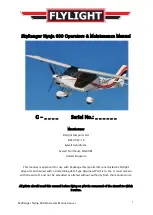
9
Collapse of the canopy
Remember this is a high performance paraglider with corresponding reactions to
disturbances in the air. Whenever in doubt, let up the brakes and let the glider fly. The
glider has a high internal pressure, resistance to tucking and very high degree of passive
safety. It is recommended that at this stage you already master an active flying style. The
key to active piloting is keeping the glider above your head at all times. We recommend
in principle that you hold the brake handle in your hand whenever possible, or fly with
your hands through the brake handles, to allow you to react immediately to any possible
disturbances.
This form of collapse occurs most frequently, caused by turbulence.
Pull the A-line slowly down, until the edge of the canopy folds in. The canopy collapses
furthest if you pull A-riser
violently down. This causes up
to 70 % of the leading edge to close up, and results in the canopy going into a spiral
towards the collapsed side. If the harness is too loosely adjusted, in a more extreme
collapse you will fall in the direction of the folded-in side, thus unintentionally magnifying
the canopy's tendency to turn.
Basically the MAGUS XC will re-open by itself from closures of up to 70% by turning of
180°. The time this takes, and the associated loss of height, can however be noticeably
reduced by appropriate action by the pilot. Apply opposite brakes on the un-collapsed
side, the outside of the curve, to stop the turning movement of the canopy. If you react
immediately, 30% brake on the open side should suffice to hold the canopy on a straight
course.
together with outermost A-line
Recovery
WARNING!!
WARNING!!
must
WARNING!!
If you fly with your hands through the brake handles, you may lose valuable
time for activating the rescue system.
Especially in turbulence, you
first stop the canopy turning, before you
pump out the collapsed side. When the canopy is stable again, open it by pulling the
brake lines on the closed side. If it is tangled, pumping the brake line should help.
Take care to avoid applying too much brake when pumping out the
deflation, as this may disrupt the airflow over the canopy and lead to a stall.
Asymmetrical collapse
Initiation
10
WARNING!!
NOTE!!
In the case of a cravat which pumping of the brakes fails to release - apply
50% -70% brake on the open side of the canopy to stop rotation. Then pull the caught line
carefully to release it then pump out the affected side. Take care to avoid applying too
much brake when pumping out the deflation, as this may disrupt the airflow over the
canopy and lead to a stall.
MAGUS XC usually opens from frontal tuck by itself. If counter braking, be
careful - do not brake too much. You could cause glider to begin a full stall with following
surge forwards.
Symmetrical collapse - "Big-Ears"
Frontal deflation
Initiation
Recovery
Initiation
Recovery
Whilst maintaining contact with the brakes, grip the outermost A1-lines. Work your
hands as high as possible on these A1-lines, until you have enough to be able to pull on
them without pulling A-risers as well. Pull outer A1-lines down simultaneously. The
further you pull the A1-lines, the greater the area of canopy that will collapse (and the
greater will be the sink rate).
As soon as you release outer A1-lines, the MAGUS XC will open slowly.(The recovery
depends on pilot's weight.) You can speed up its opening by light braking. If in extreme
cases the lines get tangled, pumping (pulling repeatedly) the brake lines should help.
If you feel strong turbulence coming, first step off the speedbar. Sometimes you may
have to pull both brakes to avoid a deflation.
Hold the brake handles in your hands and grip A-risers at the level of the maillons. Now
pull down far enough to make the whole leading edge fall in (the further you pull, the
more area folds in).
As soon as you release the A-risers, the MAGUS XC opens by itself and the glider will
recover with a corresponding surge. You can speed up this process by light braking. If
the A-risers are held too long, the canopy could fold in the middle with the wing tips going
forward.






























